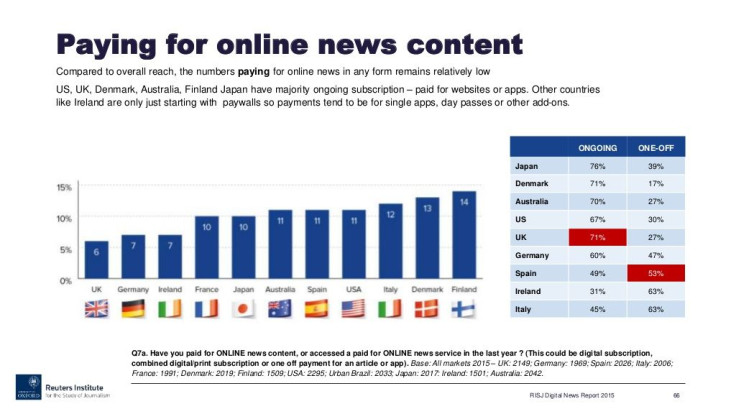Just How Is Journalism Supposed To Make Money, Anyway?

If you’ve wondered how the news media business has been able to pay for itself lately, amid falling ad prices, an aging audience and competition from tech giants, the answer is: with great difficulty. A report published Monday by the Reuters Institute for the Study of Journalism finds not only that digital journalism’s traditional sources of revenue are being depressed, but that things like sponsored content, which many publishers expected to pick up the slack, have a toxic effect on readers’ opinion of the brands that publish them.
“Current affairs, business, finance and politics sections are generally considered to be sacred by consumers,” Shaun Austin and Nic Newman wrote in an essay included in the report. “Readers feel that these areas should be free of commercial influence and retain an independent view.”
Many of the problems outlined in the report are not new. But with this latest round of evidence, it’s worth asking: Can online news support itself?
Nobody’s Buying
The news business once depended primarily on print advertising and subscription revenue. But now that news has moved online, publishers can no longer rely on subscriptions or even the occasional purchase of an individual issue of a paper or magazine. Reuters researchers found that in Finland, the country with the greatest share of readers paying for news online, just 14 percent of readers pay for what they read in some way. Denmark (13 percent) and Italy (12 percent) came in second and third; the U.S. (11 percent) and the U.K. (6 percent) came in slightly lower.

Those numbers are unlikely to grow because most people say they have no interest in paying for news, period: 75 percent of U.K. respondents, for example, and 67 percent of U.S. respondents said they would never pay for news online, no matter the cost.
Unsurprisingly, the number of people paying for news has remained effectively flat since 2013. "It appears that the number of paying users in many countries is stalling at a lower level than many news organizations hoped," professor Robert G. Picard, the North American representative of the Reuters Institute, wrote in commentary included in the report.
Ad Rates Fall
That attitude among news consumers wouldn’t be such an issue if there weren’t so many problems on the advertising front. "Online advertising – banner advertising in particular – is going through something of an existential crisis,” the Reuters report reads.
When display ads first came into wide use online, the assumption was that publishers would eventually be able to charge higher rates for them as Web audiences reached scale. In fact, the opposite has happened. While many popular, well-established news outlets have succeeded in attracting healthy audiences, the sheer number of websites out there has driven down the basic price of inventory, and it's led advertisers to look for opportunities to target increasingly specific swaths of the population, something most newspapers aren't capable of doing.
“Newspapers only offer the digital version of the print ad you might see,” said Alan Mutter, a media economics lecturer at the University of California, Berkeley Graduate School of Journalism. “They don't really offer much targeting.”
Mutter says that a typical newspaper sells less than half of its available inventory, then fills in the gaps with services like DoubleClick or other ad exchanges that simply serve. That lack of precision leads to publishers selling ads that are less relevant to readers and advertisers, which consumers simply tune out. According to the report, 30 percent of news readers say they ignore the ads they see on sites, and 47 percent of U.S. news readers use an ad blocker of some kind on their browser.
Suspicious Packages
In lieu of cutting-edge targeting, newspapers and media outlets have turned to sponsored content as an alternative, and in the space of just a few years, it's grown pervasive -- of the 76 percent of U.S. news readers who report seeing it with some regularity, nearly half of that population report seeing it often or frequently.
Those same readers have not exactly responded favorably. According to the Reuters report, half of readers say they hate it but they put up with it, a third or more say they feel disappointed or deceived when they find out a story is sponsored, and about a quarter say they think less of the publications that publish sponsored content.
Worst of all, sponsored content still suffers from a relevance problem. The Reuters report found that just 21 percent of people thought sponsored content was an interesting way to find information.
Ultimately, what led to newspapers' growth and their longtime stability was the fact that they controlled access to an audience. Today, that power rests in the hands of companies that control and mediate information that flows to consumers: Facebook, Twitter, Google, Apple. As long as they control audience, newspapers will be unable to control the price of their product.
"If you were the only newspaper in town, you could charge whatever you wanted," Mutter said. "Publishers have lost that market power."
© Copyright IBTimes 2024. All rights reserved.




















